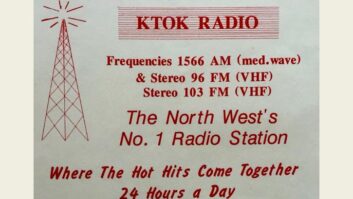The balance of power between radio listenership and live and time-shifted television viewing continues to tip in radio’s advantage, with greater reach and average audience among persons 18–34 and trending in the same direction for 18–49s. That’s based on Nielsen Media findings.
Radio sales executives have long battled TV for advertising dollars and now the shift in audience size should help give radio more of an edge when it comes to head-to-head evaluations.
Nielsen’s Q2 2021 Total Audience Report shows AM/FM radio’s weekly reach among persons 18–34 is 12% greater than television in terms of average audience, according to the marketing team at Cumulus Media.
Pierre Bouvard, chief insights officer at Cumulus Media and Westwood One, highlights the Nielsen findings in an online video and blog post posted this week. In it he outlines the latest in TV and AM/FM radio audiences using data from Nielsen’s Total Audience Report, Edison Research’s “Share of Ear,” and examples from Nielsen Media Impact.
Bouvard continues: “In the 18–49 data you can really see the full collapse of linear television. In 2018 when you look at reach 82% of 18–49 were watching at least some linear TV in a week. That has now shrunk down to 66%.”
TV’s continued viewing slide is evident, according to Nielsen’s report on Q2 2021. For instance, persons 18–49 TV audiences are down 38% since 2018. “Today, one of out of three American persons 18–49 never watch linear TV in a typical week, Bouvard said.”
When Bouvard compares radio and television, the numbers are even more striking when you consider radio’s gains in the 18–49 demographic. Weekly reach for AM/FM radio in the demo is 85% but only 66% for TV, according to the video presentation. Radio is also closing the gap in daily time spent with TV in Q2 2021 with only 30 minutes separating the two mediums.
Bouvard said AM/FM radio is poised to overtake live and time-shifted TV in average audience 18–49 by 2025; assuming current patterns projections hold true. And that changeover has already occurred when considering the 18–49 Hispanic population, Bouvard said.
“AM/FM radio beats TV among Hispanics 18–49. Radio has a massive reach advantage over linear TV. It’s 90% to 67%,” Bouvard said.
Bouvard goes on to explain the collapse of linear television, saying linear TV erosion is fueled by cord cutting and streaming. “For those who stream, half say it has replaced traditional TV,” he said. “There are three types of TV households: cordless, cord tepid and cord content.”
Bouvard concludes his presentation with an added bonus for radio time sellers from the Nielsen Media report: “AM/FM radio continues to have a dominant 76% share of ad-supported audio. When introduced into a TV media plan, AM/FM radio generates an extraordinary increase in campaign reach.”
Randy J. Stine has spent the past 40 years working in audio production and broadcast radio news. He joined Radio World in 1997 and covers new technology and regulatory issues. He has a B.A. in journalism from Michigan State University.







